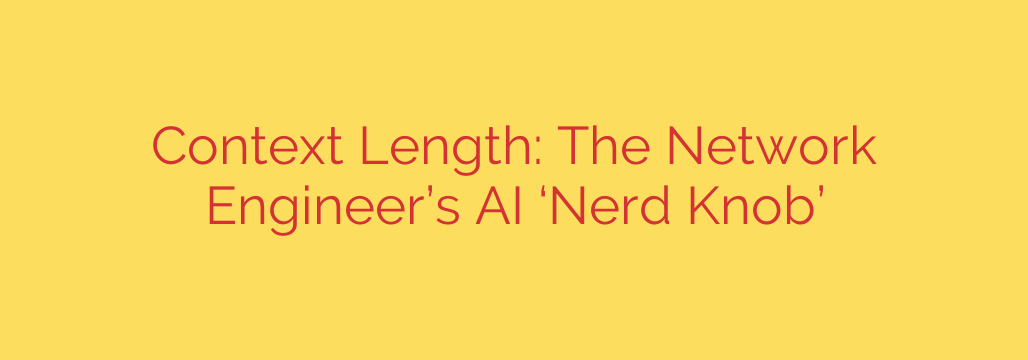
Unlocking AI for Network Engineering: Why Context Length is Your Most Powerful Tool
In the world of network engineering, complexity is the only constant. We manage sprawling infrastructures, troubleshoot cryptic performance issues, and secure an ever-expanding attack surface. While Artificial Intelligence (AI) promises to be a revolutionary ally in this fight, its practical application has often felt limited. However, a critical concept is changing the game entirely: context length.
For network professionals, understanding context length is the key to transforming AI from a clever chatbot into a powerful, indispensable engineering partner. Think of it as the ultimate technical ‘nerd knob’—a control that dictates the depth and intelligence of your AI assistant.
What Exactly is AI Context Length?
In simple terms, context length—or the context window—is the amount of information an AI model can process in a single request. It’s the AI’s short-term memory. Everything you provide it—logs, configuration files, questions, and previous commands—must fit within this window.
If the context window is too small, the AI can’t see the big picture. It’s like asking a detective to solve a case by only showing them one clue at a time. They’ll lose track of vital details and fail to connect the dots.
For network engineers, this limitation has been a major roadblock. A small context window makes it impossible to analyze the interconnected data streams that define our work, such as:
- Router and switch configurations
- Firewall rule sets and logs
- Real-time telemetry data
- Network topology diagrams
- Vendor documentation
A larger context window, however, allows the AI to hold all of this related information in its memory at once, enabling it to perform truly sophisticated analysis.
How a Large Context Window Revolutionizes Network Operations
When an AI can process vast amounts of relevant data simultaneously, its capabilities expand dramatically. This isn’t just a minor improvement; it’s a fundamental shift in how we approach network management.
1. Holistic Root Cause Analysis
Imagine a slow application performance issue. The cause could be anywhere: a misconfigured QoS policy on a router, a saturated link, a problematic firewall rule, or a DNS issue. With a large context window, you can feed the AI the following all at once:
- The configuration from the core routers and switches.
- Firewall logs from the relevant time period.
- NetFlow data showing traffic patterns.
- A clear description of the problem you are observing.
The AI can then cross-reference all this information to pinpoint the likely culprit. Instead of a vague suggestion, you get a targeted hypothesis based on a comprehensive view of the network state. This transforms troubleshooting from a manual, sequential process into a powerful, parallel analysis that drastically reduces resolution time.
2. Intelligent Configuration and Compliance Audits
Ensuring that network devices comply with security policies and best practices is a tedious and error-prone task. A large context window allows for powerful automation in this area. You can provide the AI with:
- Your organization’s complete network security policy.
- The running configuration of a Cisco, Juniper, or Arista device.
You can then ask the AI to audit the configuration against the policy, identify non-compliant rules, and even suggest the exact commands needed to fix them. This moves beyond simple script-based checks to a deeper, semantic understanding of intent versus implementation.
3. Proactive Network Automation and Optimization
The holy grail of network management is moving from a reactive to a proactive model. Large context windows are essential for this. By feeding an AI continuous streams of telemetry and log data, it can learn the normal baseline of your network’s behavior.
With this deep contextual understanding, the AI can identify subtle performance degradations or anomalous traffic patterns long before they trigger traditional alerts. It can flag a slowly failing interface or predict a future congestion point, giving you the chance to act before users are impacted.
Actionable Tips: Getting the Most Out of Your AI Assistant
Simply having a large context window isn’t enough. You must learn how to use it effectively. Treating the AI like a precision instrument will yield the best results.
- Curate Your Context: Don’t just dump raw, unfiltered data. Clean up your logs to remove irrelevant noise. Provide well-commented configuration snippets. The higher the quality of the input, the higher the quality of the output.
- Structure Your Prompt: When providing multiple data sources, clearly label them. Use markers like
---ROUTER CONFIG---,---FIREWALL LOGS---, and---PROBLEM DESCRIPTION---to help the AI organize the information. - Be Specific in Your Request: Instead of asking, “What’s wrong with my network?” ask, “Given the attached logs and configurations, why might users in the 10.1.1.0/24 subnet be experiencing high latency when accessing the web server at 203.0.113.50?”
A Critical Note on Security
The power to feed entire configurations and logs into an AI comes with significant security responsibilities. Publicly available AI models process your data on third-party servers, creating a potential for data leakage.
Before pasting any network data into an AI tool, you must:
- Sanitize All Sensitive Information: Scrub or anonymize IP addresses, usernames, passwords, SNMP community strings, and any other proprietary data.
- Favor Private AI Models: For production use, strongly consider enterprise-grade AI solutions that can be run on-premise or within a private cloud environment. This ensures your data never leaves your control.
- Implement Strict Access Controls: Treat access to these powerful AI tools with the same gravity as direct access to your core network devices.
As AI models continue to evolve with ever-larger context windows, their role in network engineering will only grow. The ability to reason over complex, interconnected datasets is precisely what has been missing from our toolkits. By mastering the ‘nerd knob’ of context length, network engineers can finally harness the full potential of AI to build more resilient, secure, and efficient networks.
Source: https://feedpress.me/link/23532/17114194/context-length-an-ai-nerd-knob-every-network-engineer-should-know








